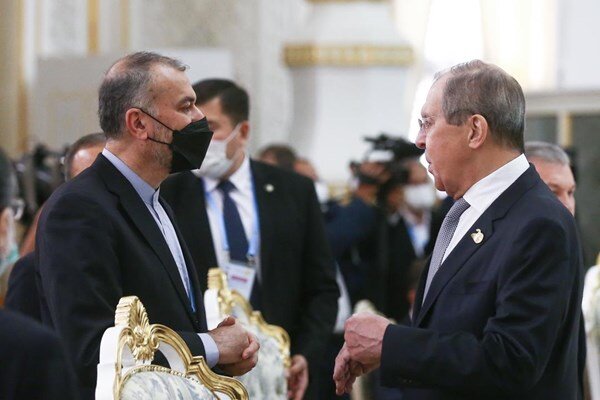Iran, Russia upgrade ties

TEHRAN – Russian Foreign Minister Sergey Lavrov arrived in Iran late on Wednesday amid a flurry of diplomatic visits to Tehran by countries facing Western sanctions.
Russian state news agency TASS said Lavrov will meet Iranian President Ayatollah Seyed Ebrahim Raisi and Iranian Foreign Minister Hossein Amir Abdollahian during his two-day visit.
Lavrov is expected to discuss with Iranian officials a full range of issues spanning economic cooperation, and political consultations on bilateral and international issues.
The visit is noteworthy for two major reasons: First, it is Lavrov’s first visit to Tehran since Ayatollah Raisi assumed the presidency in August 2021. Second, the visit comes amid growing economic sanctions by the West against Russia over the Ukraine war and uncertainties over the talks in Vienna over reviving the 2015 Iran nuclear deal.
During Lavrov’s visit, “issues around the signing of a long-term cooperation agreement and work to expand bilateral economic contacts amid the West’s tightening sanctions will be discussed. Cooperation in regional security, concerning Syria and Afghanistan, will also be key,” according to TASS.
Russia is facing blanket Western sanctions over the Ukraine war and it has overtaken Iran as the most sanctioned nation in the world, according to press reports. Exploring avenues for cooperation against sanctions is on the agenda of the visit, according to Al Araby Al Jadeed. Citing Iranian sources, the Qatari-owned newspaper said Lavrov and Iranian officials will discuss “the intensification of Iranian-Russian cooperation in the face of U.S. sanctions.”
The newspaper pointed out that Russian officials visited Iran secretly and publicly in recent months to “benefit from its experience in facing sanctions.”
Deputy Prime Minister Alexander Novak paid a visit to Iran on May 25. The Russian official met Iranian Petroleum Minister Javad Owji and First Vice President Mohammad Mokhber in Tehran. Earlier in January, President Raisi visited Russia and met with President Vladimir Putin.
This exchange of visits is part of President Raisi’s foreign policy agenda of fostering relations with neighboring countries and major non-Western powers. The policy, known as the Neighborhood Policy, saw Iran strengthening its relations with central Asian countries, China, Russia, and some Arab states.
A major part of this policy is to boost ties with countries under Western sanctions such as Venezuela, Syria, and Russia in what came to be known as the club of sanctioned countries. To this end, Iran signed long-term cooperation documents with China and Venezuela. It is in the process of signing another one with Russia.
Officials and experts of the sanctioned countries have voiced support for this kind of cooperation. Marco Fernandes, a researcher at Tricontinental Institute for Social Research, has said that the BRICS group of nations needs to focus on creating an alternative to the U.S. dollar’s hegemony in global transactions, which gives Washington leverage over its opponents, according to TASS.
Fernandes added, “After reserves and assets worth tens of billions of dollars were confiscated from countries like Venezuela, Iran, and Afghanistan, the U.S. and EU decision to freeze Russian reserves worth over $300 billion raised alarms all over the world, underscoring the need to find an alternative to the dollar’s dominance.”
Overcoming the dominance of the U.S. dollar over bilateral trade between the sanctioned countries is a major goal of the efforts to found the club of sanctioned countries.
Venezuelan Minister of Communication and Information Freddy Alfred Nazareth has said Iran and Venezuela, two sanctioned countries, are building an “economic axis.”
In an interview with state news IRNA, the Venezuelan minister said, “Iran and Venezuela will build an axis that will be a priority for the world's economies, and the 20-year comprehensive document, drawing on the experience of previous years, will pursue very clear goals for the emerging world.”
Leave a Comment